Several years ago a noted music scribe cited The Band’s second album—titled, simply, The Band—as one of “rock’s few perfect records.” While the term “rock” hardly does justice to the album’s stylistic sweep, praising the record as flawless seems pretty much spot-on. Fresh off their tenure as Bob Dylan’s backing group, band members Levon Helm, Robbie Robertson, Rick Danko, Garth Hudson and Richard Manuel had evolved into an intricately collaborative ensemble by the time they recorded this 1969 masterpiece. Speaking with this author in 2001, for a Performing Songwriter feature, Helm recalled the making of the album.
“The songs just started coming for us,” said Helm, the lone American in a group otherwise comprised of Canadian-born musicians. “We were learning through trial and error, and we started having some success with the things we were trying to do. We began finding better ways to record, and better ways to make albums. That’s all we wanted to do. We didn’t play any shows, and we didn’t consider doing anything else. We just kept ourselves in a ‘studio recording’ mode for almost two years.”
The Band’s decision to hunker down in the studio was understandable. Recruited by Dylan prior to his 1966 motorcycle accident, the Band served as the singer’s backing group as he transitioned toward a fuller, more rock-oriented sound. Folk purists often jeered Dylan—and the Band—when they took the stage equipped with electric instruments. During this same period, roughly 1965 to 1967, the Band shared living quarters with Dylan in West Saugerties, New York—jamming, writing and rehearsing in a house they called Big Pink.
“Songwriting-wise, when you get right down to it, Bob pretty much took us down into the basement of Big Pink and showed us how it’s done,” said Helm, who passed away in 2012. “Bob is one of the greatest friends I’ve ever had. He certainly did as much for the Band, and myself, as anybody ever did. When the crowds were booing him, and people were telling him, ‘You don’t need these guys,’ it would have been real easy for him to say, ‘Yeah, you’re right.’ But he never got shaky or unsteady. He was fantastic.”
Having released their debut, Music from Big Pink, in July 1968, the Band began work on their second album the following spring. Traveling to Los Angeles, the group settled in a house owned by Sammy Davis Jr.—in the Hollywood Hills—as the locale for the sessions. Converting the adjacent pool-house into a recording studio, the Band fashioned a makeshift workshop environment similar to the one at Big Pink. Most of the songwriting credits ended up going to Robertson, but Helm was adamant in saying the bulk of the compositions were collective efforts.

The Band in the kitchen of “Big Pink,” Easter Sunday, 1968, West Saugerties, NY, several months before the second album was recorded. (L-R) Rick Danko, Richard Manuel, Levon Helm, Garth Hudson, Robbie Robertson (Photo © Elliott Landy; used with permission)
“Sometimes we would grow the songs from scratch, right there in the pool-house,” he said. “Sometimes we would just pull them out of thin air. We had story songs, we had picture songs and we had songs that emulated things we had heard. One thing that helped is that we had two different styles of rhythm section, with Richard and me swapping drum duties. That was done mainly to accommodate Garth’s ability to trade instruments around. Of course, Garth could play percussion, woodwind, bass—just about anything.”
The material that emerged from the sessions was, in a word, transcendent. Flavored with rustic instrumentation, and teeming with salt-of-the-earth characters and rural imagery, songs such as “Rockin’ Chair” and “King Harvest (Has Surely Come)” evoked America’s pioneer history and frontier spirit. At their best—as with the melancholy “Whispering Pines” and the fiery Civil War meditation “The Night They Drove Old Dixie Down”—the songs approached musical terrain not far removed from that of Stephen Foster.
Watch The Band perform “The Night They Drove Old Dixie Down” at “The Last Waltz” concert in 1976
As regards the arrangements, much of The Band’s jamboree spirit stemmed from the versatility of Helm and the other players. On the bawdy “Rag Mama Rag,” for instance, Manuel assumed drummer duties while Helm played mandolin, and regular bassist Danko contributed violin while co-producer John Simon performed bass lines on a tuba. Quirky ideas such as those flowed freely, as when Hudson created the Jew’s harp sound on “Up on Cripple Creek” by running his clavinet through a wah pedal.
Key to the proceedings as well were The Band’s raggedly inspired vocal harmonies. Weighted equally, the voices of Helm, Danko and Manuel sometimes sounded like a backwoods gospel choir.
“We felt the Staple Singers were the best background singers in the world,” Helm explained. “We were always trying to emulate their singing style. That’s probably where we first got the idea of swapping the lead vocal around, because Mavis and Pop Staples could do that with the greatest of ease. Delaney and Bonnie and Friends was one of our favorite groups too. They had at least three or four lead singers in that outfit, and they all sang background harmonies for each other as well. We spent a lot of time singing standards among ourselves—practicing harmony leads and swapping the parts around, and trying to learn to do background voices. The Band didn’t really have a lead singer.”
Well over a half-century after its September 22, 1969 release, The Band remains a touchstone for any artist who strives to capture in music the elusive character of America’s unique history. In a fitting tribute, in 2009 the album was added to the National Recording Registry—an honor accorded works that are “culturally, historically, or aesthetically important, and/or informs or reflects life in the United States.”
“We were just putting songs together, and this is how they turned out,” said Helm, offering a modest assessment. “Everybody contributed as much as they could. It was just good, honest music.”
Watch rare footage of The Band performing “Up On Cripple Creek” inside of Big Pink in 1969
Related: “The Last Waltz” – An audience member revisits
The Band’s recordings—including many expanded editions—are available in the U.S. here and in the U.K. here.
- Singing Rock Drummers: From the Skins to the Mike - 03/02/2025
- Rod Stewart & Friends: 10 Great Collaborations - 01/10/2025
- Band on the Run: The LP That ‘Saved’ McCartney - 12/05/2024







6 Comments so far
Jump into a conversationWow..the video clip at the end of the story is pure gold. As is the clip it leads to…Garth going back to visit Big Pink for the 1st time in 47 years. Highly recommend checking it out. There’s some great bands around these days influenced by The Band but I doubt they’ll ever be able to write as many memorable tunes as The Band did. There’s just no band like The Band..truly original and with so much down home talent that produced so many great songs that’ll outlive us all.
“There’s just no band like The Band” … true, and the post-Last-Waltz incarnations of The Band don’t compare to the original The Band either.
I could have sworn Robbie Robertson played on that album.
Yeah pretty sure he did but when you try to claim it was all you a little payback is in order. It was The Band not Robbie Robertson and The Band.
I love the bands musicianship but I cant relate to some of their songs.I love cripple creek,the load, and stage fright but songs like dixie I just dont get
Hopefully The Night They Drove Old Dixie Down (one of the greatest) won’t be the next victim of cancel culture.